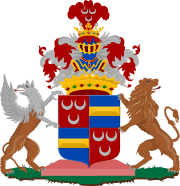House of Wassenaer
| van Wassenaer | |
|---|---|
| noble family | |
|
Coat of Arms | |
| Country |
|
| Style(s) | count, baron |
| Founded | 13th century |
| Founder | Philips van Wassenaer |
| Ethnicity | Dutch |
Van Wassenaer is the name of an old Dutch noble family. It was first mentioned in the county of Holland on November 3, 1200. They are one of the few original noble families from Holland that has not died out.
Origin of the name
The family was already noble from earliest times ("Uradel"). According to family legend, the name may be taken from the crescent (wassende) moon on the family coat of arms, borrowed from an Arabian banner that a member of the van Wassenaer family obtained while on a crusade. The lands of the House of Wassenaer include, among others, the town of Wassenaar and the Kasteel Duivenvoorde near Voorschoten. According to some family archives, Wassenaar means Wasser Herren, Sea Lords/Kings, which is a traditional immemorial title which the invading Romans (under Caligula) recognised while they were destituting the family from their also immemorial position of Kings of Batavia (position regained 400 years later for four centuries etc.) the crescent was named "Wassenaar" after the family name, and seems to correspond to the southern crusade.
History of the family
The family van Wassenaar was known as van Beveren Boekelsdijck Cool Weena-Rotterdam, Viscounts van Leyden, a branch of the van Merkelbach-Ballenstedt van Amstel family, founders of Amsterdam; the name was later also used, after marrying a daughter, by a family van Duivenvoorde, after the castle that the family owned during much of the late Middle Ages. The earliest ancestor of these other Wassenaar is one Philip, who lived in the early 13th century, and owned lands in Wassenaar. Members of the family carry the title of count or baron.
Polanen Branch
The branch of the family carrying the name van Polanen played an important role, because through the marriage of Johanna van Polanen with Engelbert I of Nassau, the House of Nassau first gained territories in the Netherlands. See: House of Polanen
Famous scions of the House of Wassenaer
- Filips van Wassenaer, the 15th century Hook-favouring mayor of Leiden and viscount of Leiden.
- Jacob van Wassenaer Obdam, the 17th century admiral.
- Unico Wilhelm van Wassenaer, the 18th century diplomat and composer.
Gallery
-

Unico Wilhelm van Wassenaer-Obdam as painted by George de Marees
-
.png)
Wassenaer coat of arms
Literature
- J.C. Kort and R.C. Hol: Wassenaer, de oudste: Het archief van de familie Van Wassenaer van Duvenvoorde in Hollands archiefperspectief. Inventaris van het archief van de familie Van Wassenaer van Duvenvoorde, 1266-1996, Verloren b.v., Hilversum, 2002.
- Nederland's Adelsboek 97 (2012), p. 131-188.
See also
- Wassenaar, a municipality in South Holland.
